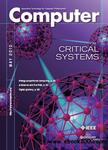版权所有:内蒙古大学图书馆 技术提供:维普资讯• 智图
内蒙古自治区呼和浩特市赛罕区大学西街235号 邮编: 010021

作者机构:NYUCOMP SCINEW YORKNY 10003
出 版 物:《COMPUTER》 (IEEE计算机杂志)
年 卷 期:1992年第25卷第2期
页 面:33-42页
核心收录:
学科分类:0808[工学-电气工程] 08[工学] 0835[工学-软件工程] 0812[工学-计算机科学与技术(可授工学、理学学位)]
基 金:uate Research Fellowship. Access to a Connection Machine was made possible through the DARPA Connection Machine Network Server Program we especially thank the University of Maryland UMIACS center. We thank L. Tucker, A. Mainwaring, and E. Zelnio for discussions and support. H. Wolf-son contributed substantially to the research, and his assistance is gratefully acknowledged
主 题:Connection Machine broadcast facilities building-block parallel algorithms computational geometry computerised pattern recognition data structures dot patterson extracted features geometric hashing geometric properties hash table data structure model information multiple-viewpoint parallel algorithms parallel hypercube techniques parallel machines parallel programming preprocessing phase recognition phase
摘 要:The parallelizability of geometric hashing is explored, and two algorithms are presented. Geometric hashing uses the collection of models in a preprocessing phase (executed off line) to build a hash table data structure. The data structure encodes the model information in a highly redundant, multiple-viewpoint way. During the recognition phase, when presented with a scene and extracted features, the hash table data structure indexes geometric properties of the scene features to candidate models. The first uses: parallel hypercube techniques to route information through a series of maps and building-block parallel algorithms. The second algorithm uses the Connection Machine s large memory resources and achieves parallelism through broadcast facilities from the front end. The discussion is confined to the problem of recognizing dot patterson embedded in a scene after they have undergone translation, rotation, and scale changes